TML Educare Assignment: Assessment Types in Education and Training
VerifiedAdded on 2021/10/01
|5
|1204
|261
Homework Assignment
AI Summary
This assignment, submitted by a student to TML Educare, delves into the realm of educational assessment, specifically focusing on three key types: diagnostic, formative, and summative assessments. The assignment begins by defining each assessment type, providing examples of their implementation, and outlining the scoring methods and assessment terms associated with each. The student then compares and contrasts these assessment types, highlighting how the results can inform the teacher's understanding of their students' learning. Finally, the assignment suggests three practical ways to adjust lesson plans and the classroom environment based on the test results. These adjustments include being flexible and responsive to the classroom atmosphere, preparing thoughtful lessons backed by data, and adjusting lesson content based on student needs. The assignment draws upon various online resources to support its analysis and recommendations.
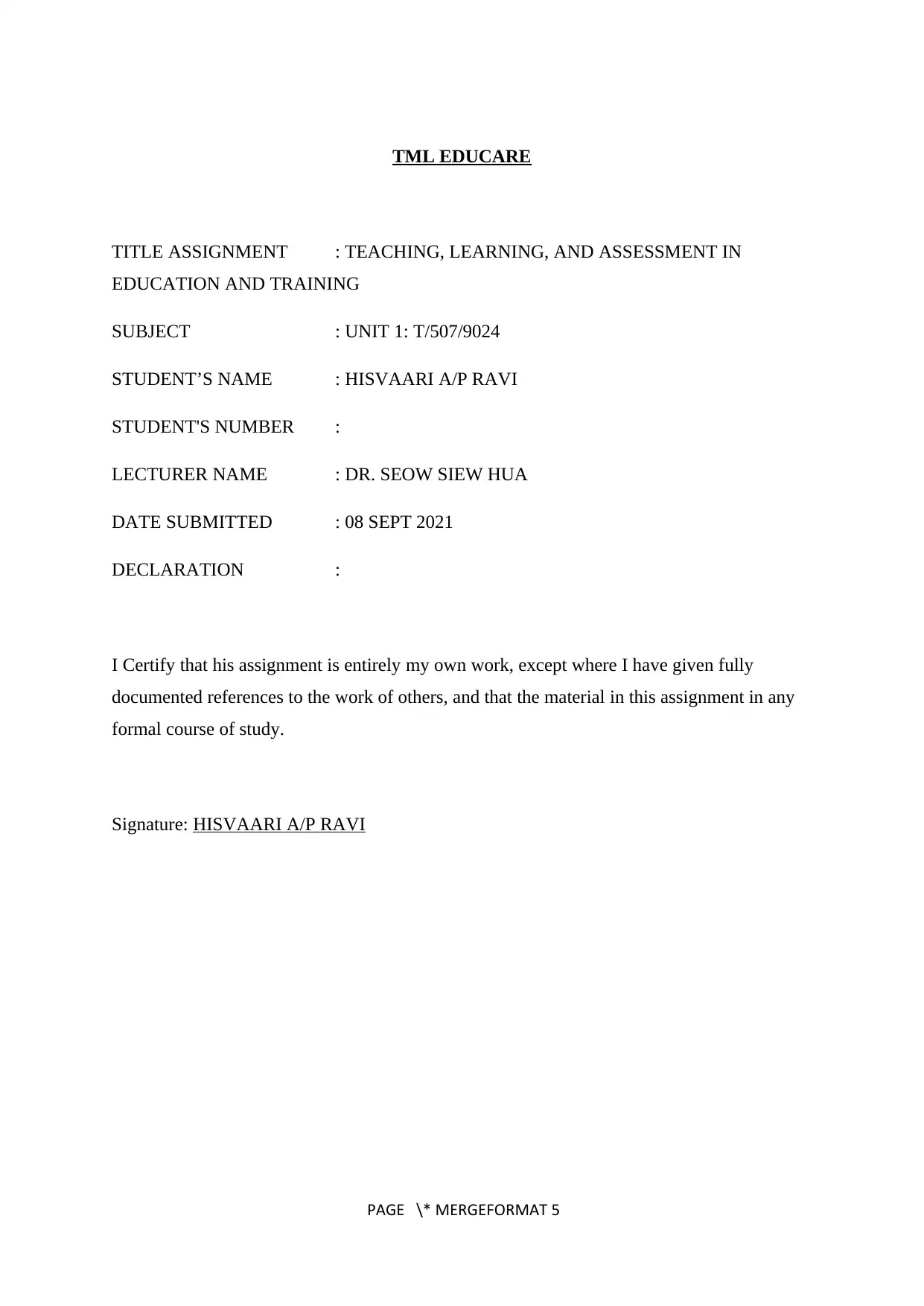
TML EDUCARE
TITLE ASSIGNMENT : TEACHING, LEARNING, AND ASSESSMENT IN
EDUCATION AND TRAINING
SUBJECT : UNIT 1: T/507/9024
STUDENT’S NAME : HISVAARI A/P RAVI
STUDENT'S NUMBER :
LECTURER NAME : DR. SEOW SIEW HUA
DATE SUBMITTED : 08 SEPT 2021
DECLARATION :
I Certify that his assignment is entirely my own work, except where I have given fully
documented references to the work of others, and that the material in this assignment in any
formal course of study.
Signature: HISVAARI A/P RAVI
PAGE \* MERGEFORMAT 5
TITLE ASSIGNMENT : TEACHING, LEARNING, AND ASSESSMENT IN
EDUCATION AND TRAINING
SUBJECT : UNIT 1: T/507/9024
STUDENT’S NAME : HISVAARI A/P RAVI
STUDENT'S NUMBER :
LECTURER NAME : DR. SEOW SIEW HUA
DATE SUBMITTED : 08 SEPT 2021
DECLARATION :
I Certify that his assignment is entirely my own work, except where I have given fully
documented references to the work of others, and that the material in this assignment in any
formal course of study.
Signature: HISVAARI A/P RAVI
PAGE \* MERGEFORMAT 5
Paraphrase This Document
Need a fresh take? Get an instant paraphrase of this document with our AI Paraphraser
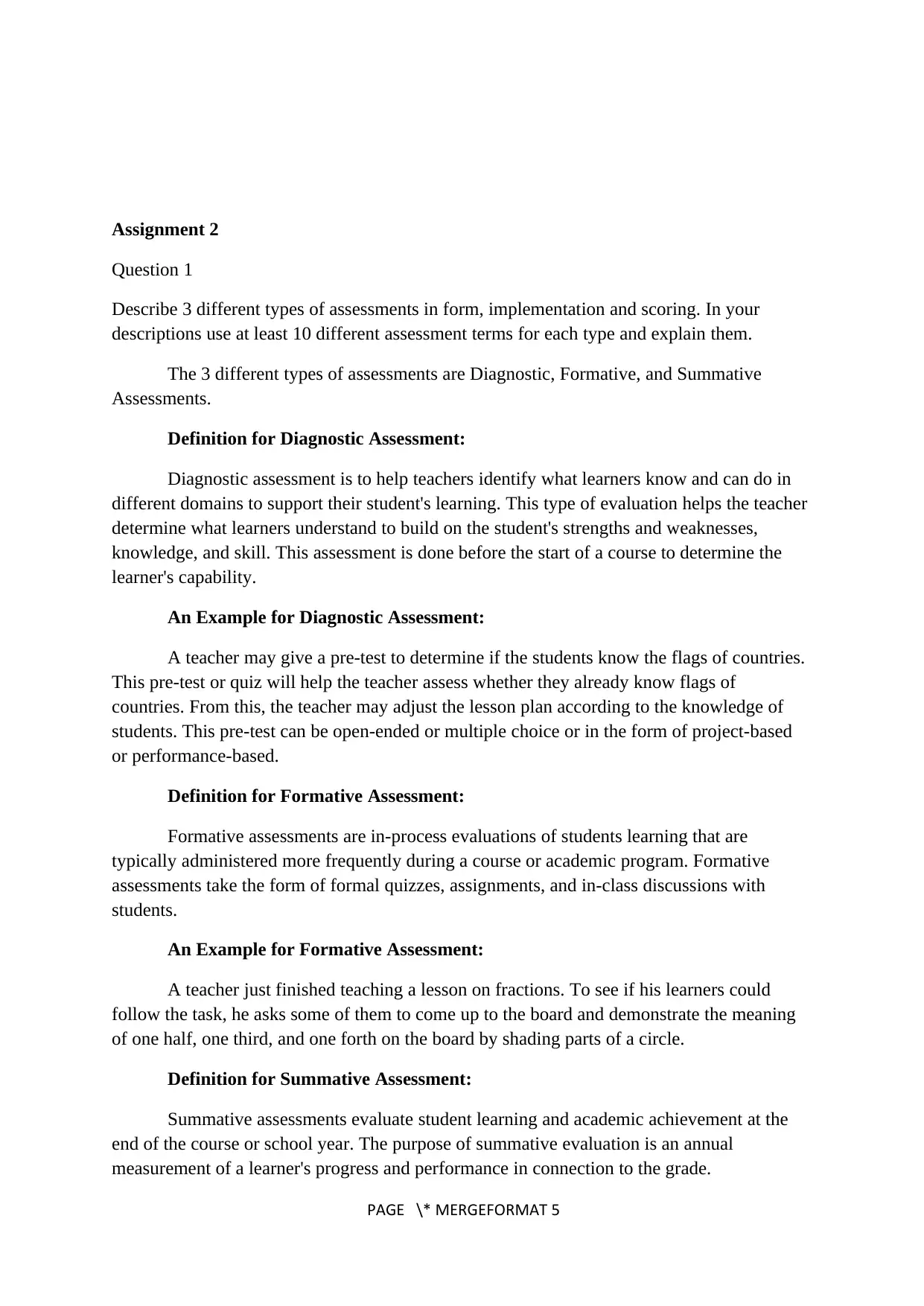
Assignment 2
Question 1
Describe 3 different types of assessments in form, implementation and scoring. In your
descriptions use at least 10 different assessment terms for each type and explain them.
The 3 different types of assessments are Diagnostic, Formative, and Summative
Assessments.
Definition for Diagnostic Assessment:
Diagnostic assessment is to help teachers identify what learners know and can do in
different domains to support their student's learning. This type of evaluation helps the teacher
determine what learners understand to build on the student's strengths and weaknesses,
knowledge, and skill. This assessment is done before the start of a course to determine the
learner's capability.
An Example for Diagnostic Assessment:
A teacher may give a pre-test to determine if the students know the flags of countries.
This pre-test or quiz will help the teacher assess whether they already know flags of
countries. From this, the teacher may adjust the lesson plan according to the knowledge of
students. This pre-test can be open-ended or multiple choice or in the form of project-based
or performance-based.
Definition for Formative Assessment:
Formative assessments are in-process evaluations of students learning that are
typically administered more frequently during a course or academic program. Formative
assessments take the form of formal quizzes, assignments, and in-class discussions with
students.
An Example for Formative Assessment:
A teacher just finished teaching a lesson on fractions. To see if his learners could
follow the task, he asks some of them to come up to the board and demonstrate the meaning
of one half, one third, and one forth on the board by shading parts of a circle.
Definition for Summative Assessment:
Summative assessments evaluate student learning and academic achievement at the
end of the course or school year. The purpose of summative evaluation is an annual
measurement of a learner's progress and performance in connection to the grade.
PAGE \* MERGEFORMAT 5
Question 1
Describe 3 different types of assessments in form, implementation and scoring. In your
descriptions use at least 10 different assessment terms for each type and explain them.
The 3 different types of assessments are Diagnostic, Formative, and Summative
Assessments.
Definition for Diagnostic Assessment:
Diagnostic assessment is to help teachers identify what learners know and can do in
different domains to support their student's learning. This type of evaluation helps the teacher
determine what learners understand to build on the student's strengths and weaknesses,
knowledge, and skill. This assessment is done before the start of a course to determine the
learner's capability.
An Example for Diagnostic Assessment:
A teacher may give a pre-test to determine if the students know the flags of countries.
This pre-test or quiz will help the teacher assess whether they already know flags of
countries. From this, the teacher may adjust the lesson plan according to the knowledge of
students. This pre-test can be open-ended or multiple choice or in the form of project-based
or performance-based.
Definition for Formative Assessment:
Formative assessments are in-process evaluations of students learning that are
typically administered more frequently during a course or academic program. Formative
assessments take the form of formal quizzes, assignments, and in-class discussions with
students.
An Example for Formative Assessment:
A teacher just finished teaching a lesson on fractions. To see if his learners could
follow the task, he asks some of them to come up to the board and demonstrate the meaning
of one half, one third, and one forth on the board by shading parts of a circle.
Definition for Summative Assessment:
Summative assessments evaluate student learning and academic achievement at the
end of the course or school year. The purpose of summative evaluation is an annual
measurement of a learner's progress and performance in connection to the grade.
PAGE \* MERGEFORMAT 5
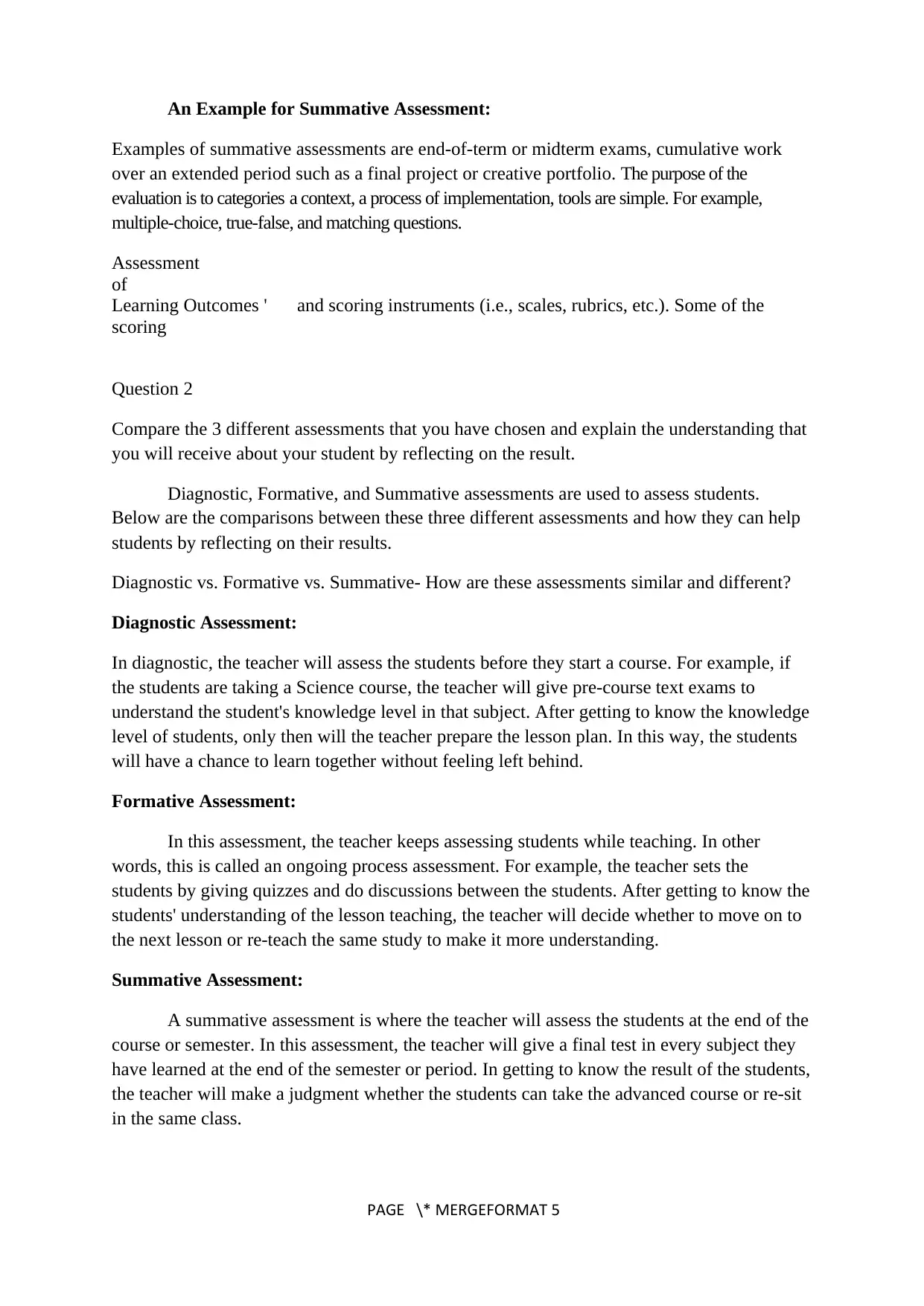
An Example for Summative Assessment:
Examples of summative assessments are end-of-term or midterm exams, cumulative work
over an extended period such as a final project or creative portfolio. The purpose of the
evaluation is to categories a context, a process of implementation, tools are simple. For example,
multiple-choice, true-false, and matching questions.
Assessment
of
Learning Outcomes ' and scoring instruments (i.e., scales, rubrics, etc.). Some of the
scoring
Question 2
Compare the 3 different assessments that you have chosen and explain the understanding that
you will receive about your student by reflecting on the result.
Diagnostic, Formative, and Summative assessments are used to assess students.
Below are the comparisons between these three different assessments and how they can help
students by reflecting on their results.
Diagnostic vs. Formative vs. Summative- How are these assessments similar and different?
Diagnostic Assessment:
In diagnostic, the teacher will assess the students before they start a course. For example, if
the students are taking a Science course, the teacher will give pre-course text exams to
understand the student's knowledge level in that subject. After getting to know the knowledge
level of students, only then will the teacher prepare the lesson plan. In this way, the students
will have a chance to learn together without feeling left behind.
Formative Assessment:
In this assessment, the teacher keeps assessing students while teaching. In other
words, this is called an ongoing process assessment. For example, the teacher sets the
students by giving quizzes and do discussions between the students. After getting to know the
students' understanding of the lesson teaching, the teacher will decide whether to move on to
the next lesson or re-teach the same study to make it more understanding.
Summative Assessment:
A summative assessment is where the teacher will assess the students at the end of the
course or semester. In this assessment, the teacher will give a final test in every subject they
have learned at the end of the semester or period. In getting to know the result of the students,
the teacher will make a judgment whether the students can take the advanced course or re-sit
in the same class.
PAGE \* MERGEFORMAT 5
Examples of summative assessments are end-of-term or midterm exams, cumulative work
over an extended period such as a final project or creative portfolio. The purpose of the
evaluation is to categories a context, a process of implementation, tools are simple. For example,
multiple-choice, true-false, and matching questions.
Assessment
of
Learning Outcomes ' and scoring instruments (i.e., scales, rubrics, etc.). Some of the
scoring
Question 2
Compare the 3 different assessments that you have chosen and explain the understanding that
you will receive about your student by reflecting on the result.
Diagnostic, Formative, and Summative assessments are used to assess students.
Below are the comparisons between these three different assessments and how they can help
students by reflecting on their results.
Diagnostic vs. Formative vs. Summative- How are these assessments similar and different?
Diagnostic Assessment:
In diagnostic, the teacher will assess the students before they start a course. For example, if
the students are taking a Science course, the teacher will give pre-course text exams to
understand the student's knowledge level in that subject. After getting to know the knowledge
level of students, only then will the teacher prepare the lesson plan. In this way, the students
will have a chance to learn together without feeling left behind.
Formative Assessment:
In this assessment, the teacher keeps assessing students while teaching. In other
words, this is called an ongoing process assessment. For example, the teacher sets the
students by giving quizzes and do discussions between the students. After getting to know the
students' understanding of the lesson teaching, the teacher will decide whether to move on to
the next lesson or re-teach the same study to make it more understanding.
Summative Assessment:
A summative assessment is where the teacher will assess the students at the end of the
course or semester. In this assessment, the teacher will give a final test in every subject they
have learned at the end of the semester or period. In getting to know the result of the students,
the teacher will make a judgment whether the students can take the advanced course or re-sit
in the same class.
PAGE \* MERGEFORMAT 5
⊘ This is a preview!⊘
Do you want full access?
Subscribe today to unlock all pages.

Trusted by 1+ million students worldwide
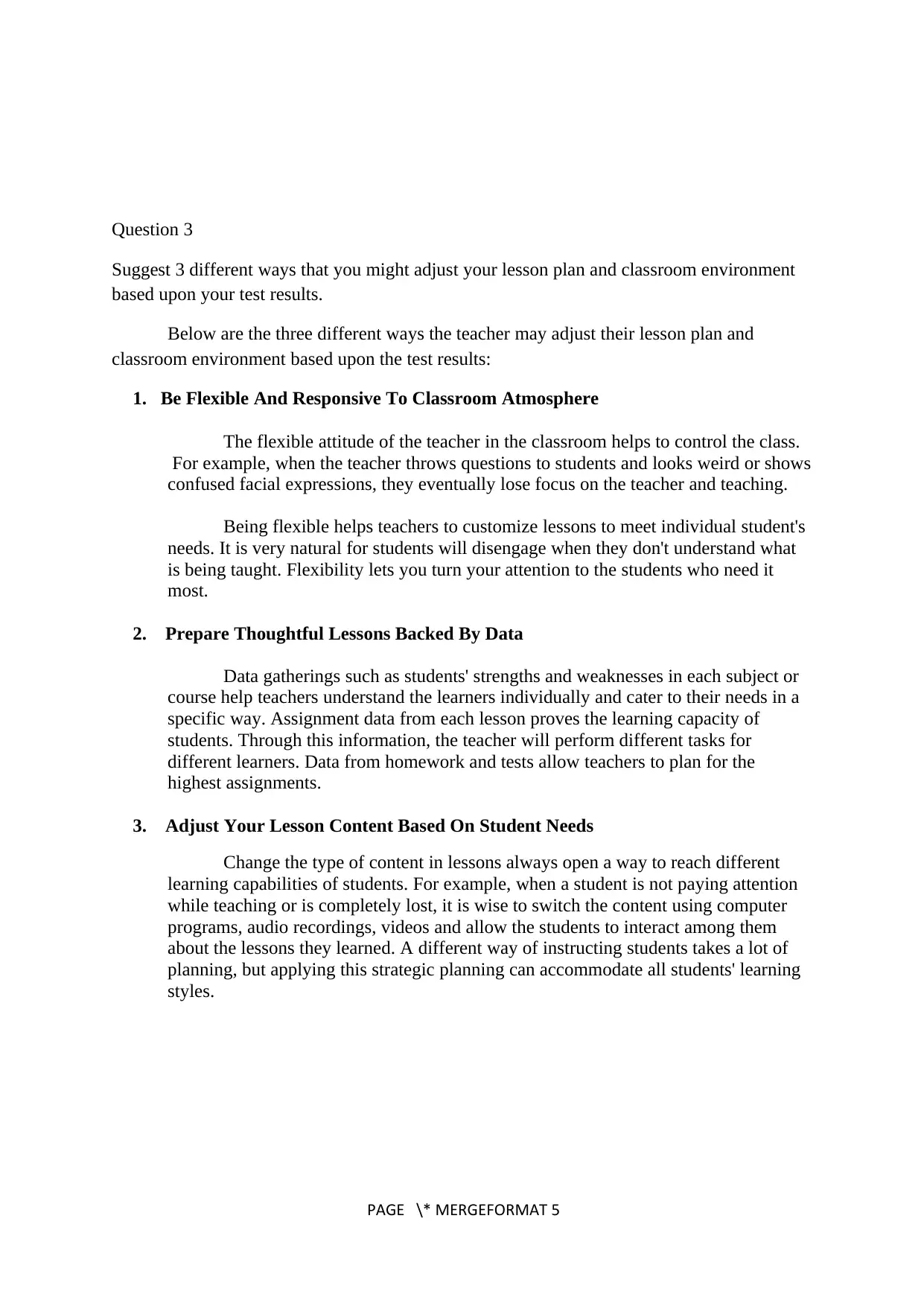
Question 3
Suggest 3 different ways that you might adjust your lesson plan and classroom environment
based upon your test results.
Below are the three different ways the teacher may adjust their lesson plan and
classroom environment based upon the test results:
1. Be Flexible And Responsive To Classroom Atmosphere
The flexible attitude of the teacher in the classroom helps to control the class.
For example, when the teacher throws questions to students and looks weird or shows
confused facial expressions, they eventually lose focus on the teacher and teaching.
Being flexible helps teachers to customize lessons to meet individual student's
needs. It is very natural for students will disengage when they don't understand what
is being taught. Flexibility lets you turn your attention to the students who need it
most.
2. Prepare Thoughtful Lessons Backed By Data
Data gatherings such as students' strengths and weaknesses in each subject or
course help teachers understand the learners individually and cater to their needs in a
specific way. Assignment data from each lesson proves the learning capacity of
students. Through this information, the teacher will perform different tasks for
different learners. Data from homework and tests allow teachers to plan for the
highest assignments.
3. Adjust Your Lesson Content Based On Student Needs
Change the type of content in lessons always open a way to reach different
learning capabilities of students. For example, when a student is not paying attention
while teaching or is completely lost, it is wise to switch the content using computer
programs, audio recordings, videos and allow the students to interact among them
about the lessons they learned. A different way of instructing students takes a lot of
planning, but applying this strategic planning can accommodate all students' learning
styles.
PAGE \* MERGEFORMAT 5
Suggest 3 different ways that you might adjust your lesson plan and classroom environment
based upon your test results.
Below are the three different ways the teacher may adjust their lesson plan and
classroom environment based upon the test results:
1. Be Flexible And Responsive To Classroom Atmosphere
The flexible attitude of the teacher in the classroom helps to control the class.
For example, when the teacher throws questions to students and looks weird or shows
confused facial expressions, they eventually lose focus on the teacher and teaching.
Being flexible helps teachers to customize lessons to meet individual student's
needs. It is very natural for students will disengage when they don't understand what
is being taught. Flexibility lets you turn your attention to the students who need it
most.
2. Prepare Thoughtful Lessons Backed By Data
Data gatherings such as students' strengths and weaknesses in each subject or
course help teachers understand the learners individually and cater to their needs in a
specific way. Assignment data from each lesson proves the learning capacity of
students. Through this information, the teacher will perform different tasks for
different learners. Data from homework and tests allow teachers to plan for the
highest assignments.
3. Adjust Your Lesson Content Based On Student Needs
Change the type of content in lessons always open a way to reach different
learning capabilities of students. For example, when a student is not paying attention
while teaching or is completely lost, it is wise to switch the content using computer
programs, audio recordings, videos and allow the students to interact among them
about the lessons they learned. A different way of instructing students takes a lot of
planning, but applying this strategic planning can accommodate all students' learning
styles.
PAGE \* MERGEFORMAT 5
Paraphrase This Document
Need a fresh take? Get an instant paraphrase of this document with our AI Paraphraser
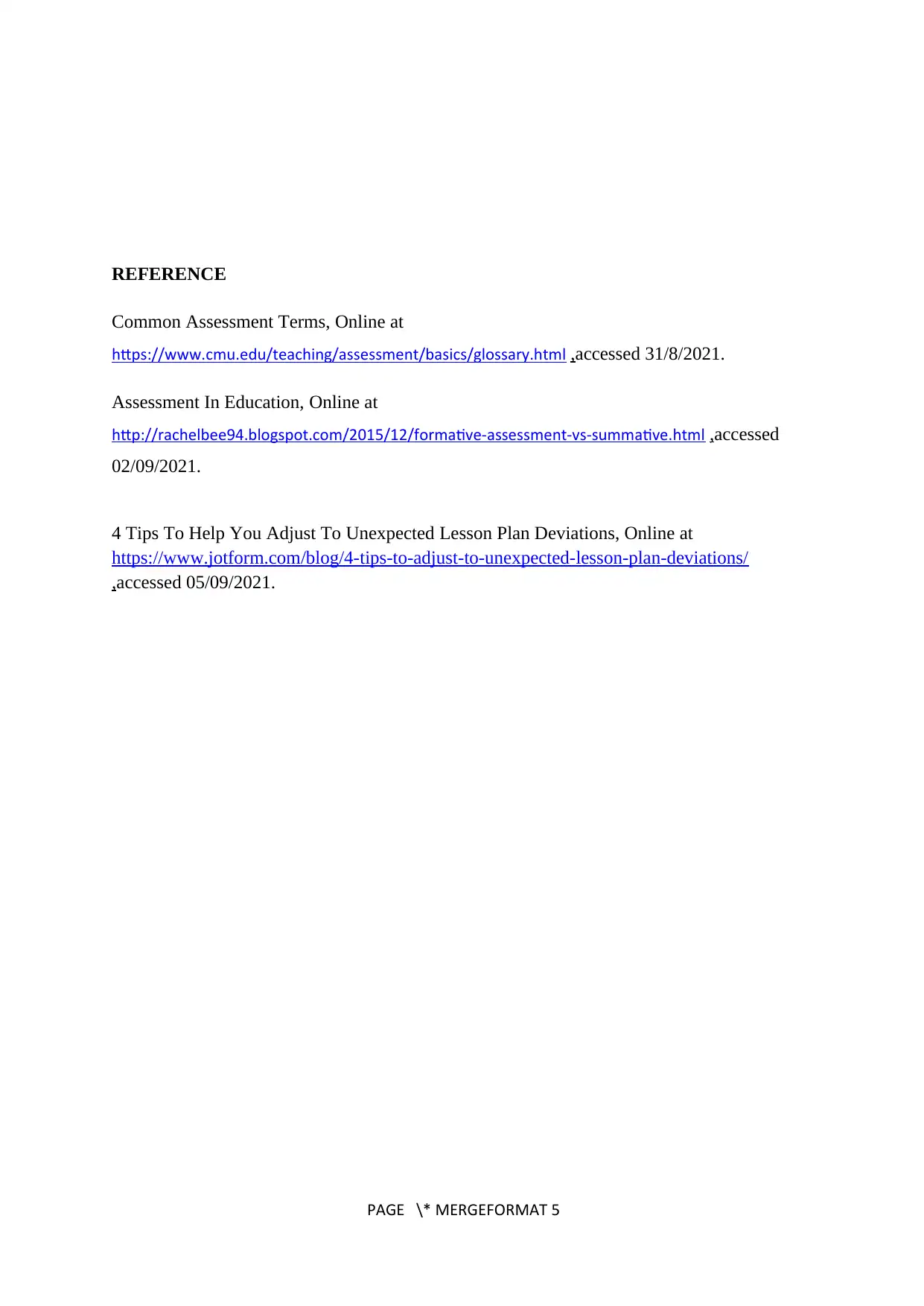
REFERENCE
Common Assessment Terms, Online at
https://www.cmu.edu/teaching/assessment/basics/glossary.html ,accessed 31/8/2021.
Assessment In Education, Online at
http://rachelbee94.blogspot.com/2015/12/formative-assessment-vs-summative.html ,accessed
02/09/2021.
4 Tips To Help You Adjust To Unexpected Lesson Plan Deviations, Online at
https://www.jotform.com/blog/4-tips-to-adjust-to-unexpected-lesson-plan-deviations/
,accessed 05/09/2021.
PAGE \* MERGEFORMAT 5
Common Assessment Terms, Online at
https://www.cmu.edu/teaching/assessment/basics/glossary.html ,accessed 31/8/2021.
Assessment In Education, Online at
http://rachelbee94.blogspot.com/2015/12/formative-assessment-vs-summative.html ,accessed
02/09/2021.
4 Tips To Help You Adjust To Unexpected Lesson Plan Deviations, Online at
https://www.jotform.com/blog/4-tips-to-adjust-to-unexpected-lesson-plan-deviations/
,accessed 05/09/2021.
PAGE \* MERGEFORMAT 5
1 out of 5
Related Documents
Your All-in-One AI-Powered Toolkit for Academic Success.
+13062052269
info@desklib.com
Available 24*7 on WhatsApp / Email
![[object Object]](/_next/static/media/star-bottom.7253800d.svg)
Unlock your academic potential
Copyright © 2020–2025 A2Z Services. All Rights Reserved. Developed and managed by ZUCOL.





